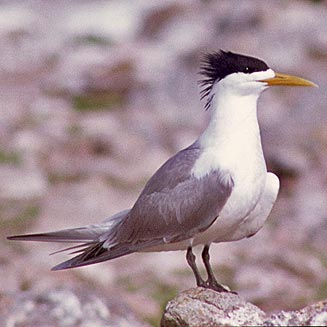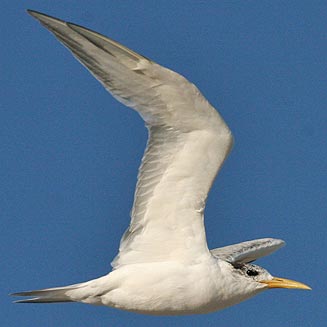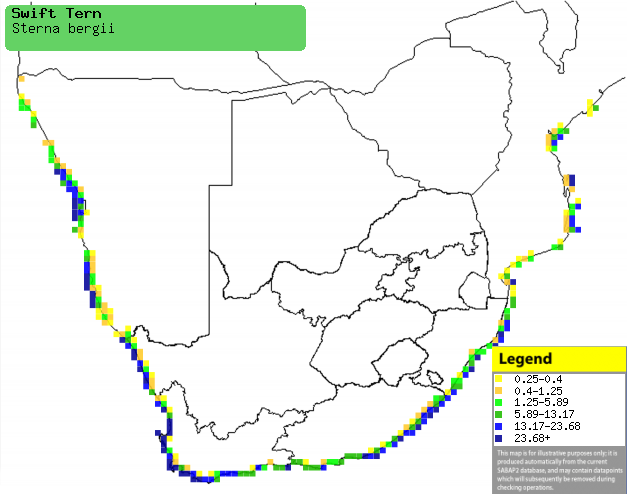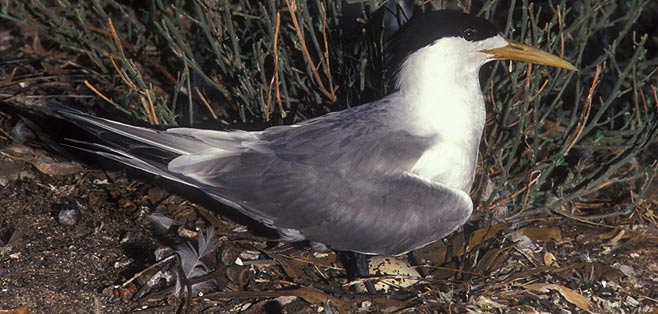|
Sterna bergii (Swift tern)
Geelbeksterretjie [Afrikaans]; Grote kuifstern [Dutch];
Sterne huppée [French]; Eilseeschwalbe [German]; Gaivina-de-bico-amarelo
[Portuguese]
Life
> Eukaryotes >
Opisthokonta
> Metazoa (animals) >
Bilateria >
Deuterostomia > Chordata >
Craniata > Vertebrata (vertebrates) > Gnathostomata (jawed
vertebrates) > Teleostomi (teleost fish) > Osteichthyes (bony fish) > Class:
Sarcopterygii (lobe-finned
fish) > Stegocephalia (terrestrial
vertebrates) > Tetrapoda
(four-legged vertebrates) > Reptiliomorpha > Amniota >
Reptilia (reptiles) >
Romeriida > Diapsida > Archosauromorpha > Archosauria >
Dinosauria
(dinosaurs) > Saurischia > Theropoda (bipedal predatory dinosaurs) >
Coelurosauria > Maniraptora > Aves
(birds) > Order: Charadriiformes
> Family: Laridae > Genus: Sterna
 |
 |
| Swift tern. (photo H. Robertson,
Iziko ©] |
Swift tern, Kleinmond, Western Cape, South
Africa. (photo H. Robertson, Iziko ©] |
Distribution and habitat
Occurs the coasts of the west-central Pacific, south-east
Atlantic, and Indian Oceans. In southern Africa it is common
along the entire coastline of the region, generally preferring lagoons,
estuaries, coastal islands and exposed ocean beaches.
|
 |
|
Distribution of Swift tern in southern Africa,
based on statistical smoothing of the records from first SA Bird Atlas
Project (©
Animal Demography unit, University of
Cape Town; smoothing by Birgit Erni and Francesca Little). Colours range
from dark blue (most common) through to yellow (least common).
See here for the latest distribution
from the SABAP2. |
Predators and parasites
Movements and migrations
After breeding, it departs from the colonies and
heads south and east to the coastline of the Indian Ocean, travelling
back again at the onset of the following breeding season.
Food
Mainly eats pelagic schooling fish, doing most of its
foraging within sight of land, plunge-diving or dipping into the sea to catch
prey. The following food items have been recorded
in its diet:
- Fish
- Engraulis encrasicolus (Anchovy)
- Sardinops sagax (Sardines)
- Sufflogobius bibarbatus (Pelagic goby)
- Merluccius (hakes, usually scavenged)
Breeding
- Monogamous, usually nesting in colonies of roughly 500-3000 pairs,
maintaining a pair bond year round.
- The nest (see image below) is a shallow scrape in flat, open sand,
either unlined or with a thin lining of stones and cuttlefish (Sepia)
bones, or alternatively it may use the roof of a building.
 |
| Swift tern on nest. [photo Peter Steyn
©] |
- Egg-laying season is from January-September, peaking from February-June.
- It lays a single egg, rarely two, which is incubated by both sexes for
about 21-30 days.
- The chicks are brooded and fed by both parents, leaving the nest after
about three days, after which it forms crèches along with other chicks,
fledging at about 38-40 days old and becoming fully independent roughly four
months later.
Threats
Not threatened, as although some colonies (such as one at
Strandfontein Sewage Works, Western Cape) have been abandoned due to predators
or bush encroachment, it is still common and widespread.
References
-
Hockey PAR, Dean WRJ and Ryan PG 2005. Roberts
- Birds of southern Africa, VIIth ed. The Trustees of the John Voelcker
Bird Book Fund, Cape Town.
|
